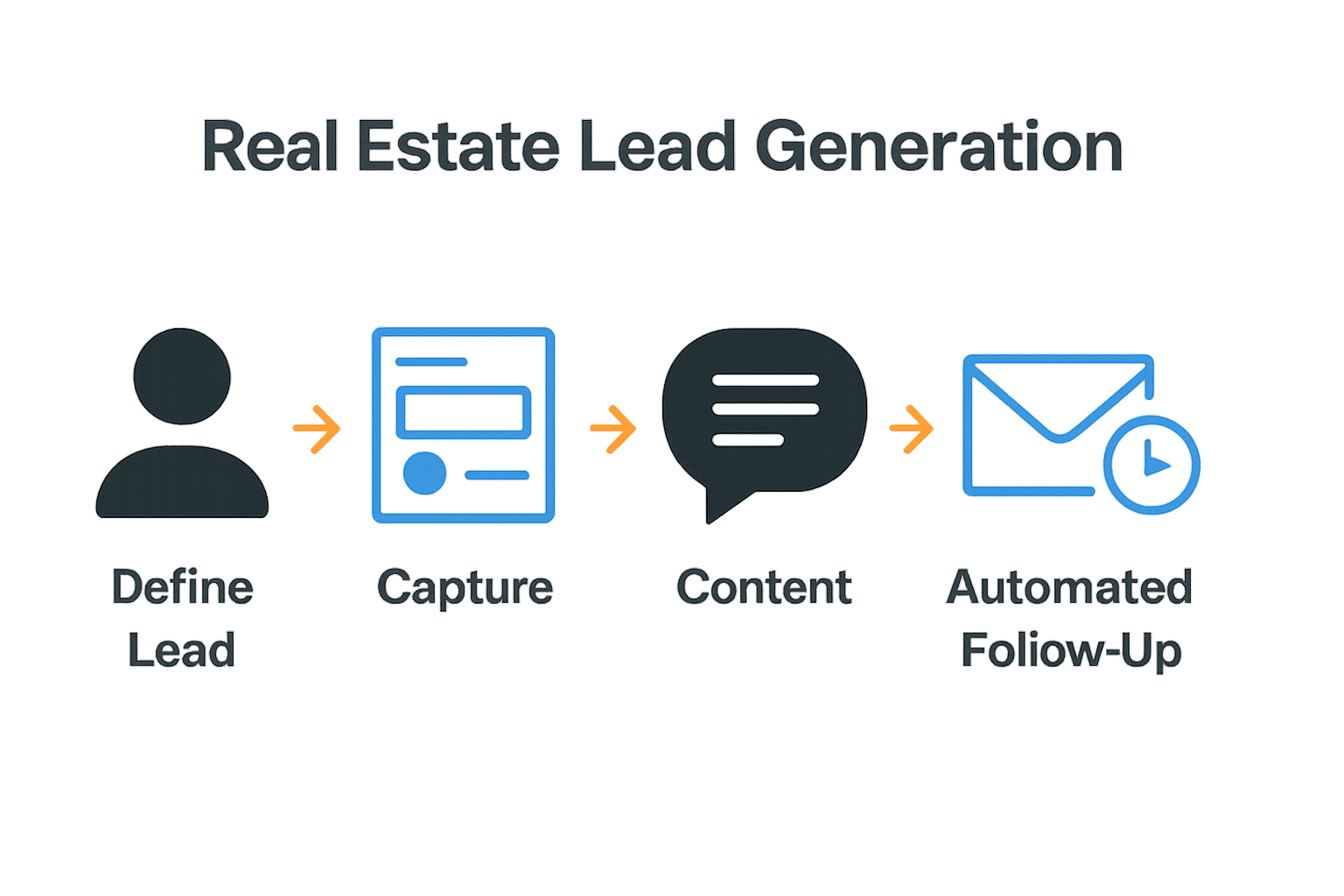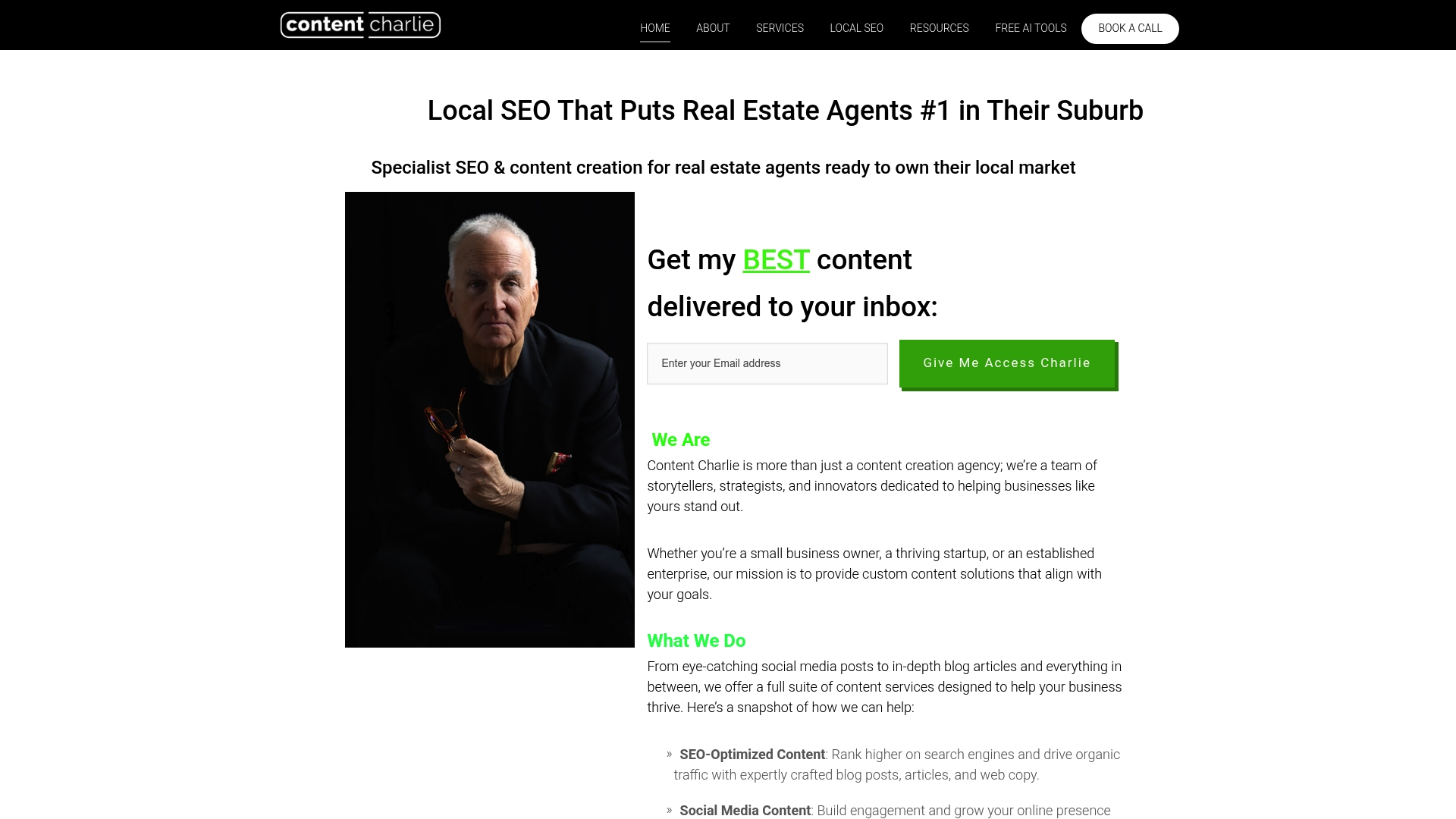- You are here:
- Home »
- SEO Content »
- Lead Generation Workflow Real Estate: Step-by-Step Success

Lead Generation Workflow Real Estate: Step-by-Step Success
Only about 25 percent of real estate leads ever become clients, according to industry studies. This gap shows how quickly wasted effort can pile up when you target the wrong audience or miss follow-up opportunities. Getting clear on who you want as a client sets the stage for better results. Learn how focusing your efforts in the right places can turn casual interest into real, profitable relationships.
Table of Contents
- Step 1: Define Your Ideal Real Estate Lead Profile
- Step 2: Set Up Targeted Lead Capture Systems
- Step 3: Develop Compelling Content And Offers
- Step 4: Implement Automated Follow-Up Sequences
- Step 5: Track Results And Refine Your Workflow
Quick Summary
| Key Point | Explanation |
|---|---|
| 1. Define Your Ideal Client Profile | Identify the specific characteristics of your target clients to tailor your marketing strategy effectively. |
| 2. Set Up Targeted Lead Capture Systems | Utilize dedicated landing pages and automation tools to attract and gather potential client information efficiently. |
| 3. Create Compelling, Targeted Content | Develop hyper-targeted content that addresses the specific needs and interests of your ideal leads to foster engagement. |
| 4. Implement Automated Follow-Up Sequences | Establish multi-channel follow-ups that adapt to lead behavior and preferences to maintain meaningful client engagement. |
| 5. Continuously Track and Refine Your Workflow | Monitor key performance metrics regularly to optimize your lead generation strategies and improve conversion rates. |
Step 1: Define your ideal real estate lead profile
Successfully generating real estate leads starts with knowing exactly who you want to attract. This step helps you create a laser focused strategy that speaks directly to your most valuable potential clients.
Building an Ideal Client Profile (ICP) allows you to understand precisely who you want to work with. According to research from lead generation experts, an ideal customer profile represents the specific set of characteristics that define your perfect client. This includes demographics like age range, income level, location preferences, and specific real estate goals.
Start by asking yourself critical questions about your target market. Are you focusing on first time home buyers in suburban neighborhoods? Luxury property investors seeking high end real estate? Commercial property developers looking for strategic acquisitions? Each group requires a unique approach.
Break down your ideal lead profile across several key dimensions:
- Geographic location (specific suburbs or regions)
- Income bracket
- Property type interests
- Career or professional background
- Family status
- Investment goals
Pro Tip: The more specific your profile, the more effectively you can tailor your marketing messages and lead generation strategies.
Once you have defined your ideal lead profile, you will be ready to create targeted marketing campaigns that resonate precisely with your desired audience. This focused approach will dramatically improve your lead conversion rates compared to generic, scattered marketing attempts.
In the next step, you will learn how to develop compelling marketing strategies specifically designed to attract your newly defined ideal real estate leads.
Step 2: Set up targeted lead capture systems
With your ideal lead profile defined, it is time to build strategic systems that will automatically attract and capture potential clients. This step transforms your marketing from random attempts to a precision targeted approach.
According to research from real estate automation experts, successful lead capture requires integrating multiple sophisticated tools. As lead generation strategies for real estate reveal, you will need a combination of website optimization, smart forms, and automated tracking mechanisms.
Start by creating dedicated landing pages tailored to your specific lead profile. These pages should include high converting forms that capture essential contact information. Design these forms to be simple yet compelling, asking only the most critical details that help you understand potential client needs.
Key components of an effective lead capture system include:
- Custom website lead capture forms
- Behavior tracking technologies
- Automated CRM integration
- AI powered chatbots for 24/7 engagement
- Segmentation tools to categorize incoming leads
Pro Tip: Implement AI chatbots that can engage potential leads immediately and collect preliminary information outside of standard business hours.
Research indicates that combining Customer Relationship Management (CRM) tools with marketing automation can dramatically improve lead conversion rates. These systems help you track interactions, segment leads based on their specific interests, and create personalized follow up strategies.
By establishing these targeted lead capture systems, you transform your approach from passive waiting to active lead generation.
 Your next step will involve developing a strategic approach to nurturing and converting these captured leads.
Your next step will involve developing a strategic approach to nurturing and converting these captured leads.
Step 3: Develop compelling content and offers
Now that you understand your ideal lead profile, it is time to create content that speaks directly to their needs and interests. This step transforms generic marketing into targeted communication that attracts and engages potential clients.
According to research on real estate lead generation, the key is developing hyper targeted content that resonates with your specific audience. Email marketing content strategies can help you craft messages that feel personal and relevant.
Start by mapping out content types that align with your ideal client profile. For investors, this might mean detailed market analysis reports. For first time home buyers, neighborhood guides and first time purchase tips work best. The goal is to provide genuine value that positions you as a trusted resource.
Consider creating content across multiple platforms:
- Neighborhood specific property guides
- Virtual property tours
- Market trend analysis reports
- First time buyer educational resources
- Investment property potential assessments
Pro Tip: Use storytelling techniques that connect emotionally while providing practical information.
Research indicates that personalized content dramatically increases engagement. By tailoring your messaging to match the specific characteristics and needs of your ideal lead profile, you transform generic outreach into compelling communication.
Your next step will involve implementing strategic distribution channels to ensure your carefully crafted content reaches the right audience at the right time.
Step 4: Implement automated follow-up sequences
Automated follow-up sequences transform sporadic lead interactions into consistent meaningful engagement. This critical step ensures no potential client falls through the cracks while maintaining a personalized approach to communication.
According to real estate automation research, the key is blending technological efficiency with a human touch. As experts from AI-driven lead management suggest, your follow-up strategy should dynamically adapt to individual lead behaviors and preferences.
Design a multi-channel sequence that includes email, SMS, and targeted content delivery. Start by segmenting your leads based on their specific interests such as property type, budget range, or location preferences. This allows you to create personalized communication paths that feel relevant and timely.
Key components of an effective automated follow-up system include:
- Triggered email sequences based on lead interactions
- Personalized content recommendations
- Scheduled check in messages
- Behavioral tracking and response adaptation
- Intelligent scheduling of communication intervals
Pro Tip: Balance automation with strategic human touchpoints to maintain authenticity and personal connection.
Research indicates that successful follow-up sequences should be designed for long term nurturing spanning 12 to 24 months. This approach recognizes that real estate decisions often require extended consideration periods.
Your next step will involve monitoring and continuously refining these automated sequences to maximize lead conversion potential.
Step 5: Track results and refine your workflow
Successful lead generation requires constant measurement and strategic refinement. This final step transforms your raw data into actionable insights that will continuously improve your real estate marketing performance.
According to lead management research, tracking the right metrics is crucial for understanding your workflow effectiveness. Lead source attribution provides a comprehensive view of where your most valuable leads originate and how they convert.
Begin by establishing a robust tracking system using tools like Google Analytics, CRM software, and specialized real estate tracking platforms. Focus on key performance indicators that reveal the true health of your lead generation strategy.
Critical metrics to monitor include:
- Lead to appointment conversion rates
- Cost per lead by source
- Response time performance
- Total lead volume
- Revenue generated per lead source
Pro Tip: Review your metrics monthly and be prepared to pivot quickly when data suggests underperformance.
Research demonstrates that systematic tracking enables real estate professionals to optimize their marketing spend and focus on channels delivering the highest quality leads. By continuously analyzing and adjusting your approach, you create a dynamic lead generation system that evolves with market conditions.

Remember that tracking is not a one time event but an ongoing process of measurement refinement and strategic adaptation.
Here’s a comparison of key components for each step in a targeted real estate lead generation workflow:
| Step | Key Focus | Essential Tools/Techniques |
|---|---|---|
| Define Ideal Lead | Demographics Needs/goals |
Client profile worksheet Market research |
| Capture Leads | Website forms CRM automation |
Landing pages Chatbots Behavior tracking |
| Create Content | Tailored messaging Value offers |
Guides Video tours Email newsletters |
| Automated Follow-up | Lead nurturing Personalization |
Email/SMS sequences AI scheduling |
| Track & Refine | Performance metrics Optimization |
Analytics platforms Monthly reviews |
Elevate Your Real Estate Lead Generation with Content Charlie
The challenge in today’s competitive real estate market is clear: how do you attract ideal leads and convert them with consistent, targeted content and a streamlined workflow? This article lays out the perfect step-by-step system from defining your ideal lead to tracking results, but putting that into action can feel overwhelming. The pain points of creating tailored content that resonates locally, capturing leads effectively, and maintaining automated yet authentic follow-ups are real obstacles for busy agents.
At Content Charlie, we specialize in solving exactly these problems. We offer local SEO and real estate copywriting that helps you dominate suburb-level searches from Broadbeach to Burleigh. Whether you need suburb guides, property descriptions, or Google Business Profile content, we provide SEO-driven, high-converting copy that ensures your brand attracts and engages the right leads. Combine our content with your lead capture and follow-up systems to transform potential clients into loyal customers.
Ready to power your lead generation workflow with words that get you found and remembered?

Discover how Content Charlie can help you create compelling, targeted content that fits seamlessly into your lead generation strategy. Visit our landing page at Content Charlie to learn more. Start turning your real estate leads into real results today.
Frequently Asked Questions
How can I define my ideal real estate lead profile?
Defining your ideal real estate lead profile starts with identifying the specific characteristics of your target clients. Break down factors such as demographics, geographic location, income bracket, and property type interests. Create a checklist of these traits to guide your marketing strategies.
What are effective lead capture systems for real estate?
Effective lead capture systems involve creating dedicated landing pages with tailored forms that capture contact information. Implement tools such as chatbots and behavior tracking to engage potential leads immediately and collect insights about their interests. Aim to develop these systems to streamline your lead generation by 30%.
How can I create compelling content for my lead generation strategies?
Creating compelling content means identifying what your ideal leads want and delivering it through various formats. Options include neighborhood guides for first-time home buyers or market analysis for investors. Plan to produce at least one new piece of relevant content each week to maintain engagement.
What components are necessary for automated follow-up sequences?
An effective automated follow-up sequence includes triggered emails, personalized content recommendations, and scheduled check-ins. By segmenting leads based on their interests and behaviors, you can create targeted communications that feel relevant. Set up your sequences to engage leads within 24 hours of their initial contact.
How do I track the success of my lead generation workflow?
Tracking the success of your lead generation workflow involves measuring key performance indicators like lead conversion rates and response times. Use tools to establish a robust tracking system and review your metrics monthly to identify areas for improvement. Aim to refine your workflow to improve lead conversions by at least 15% within a few months.
What should I do if my lead generation metrics are underperforming?
If your lead generation metrics are underperforming, start by analyzing your current strategies and identifying potential weak points. Consider adjusting your content, lead capture methods, or follow-up techniques based on your findings. Implement changes swiftly to see if you can enhance performance, ideally within the next month.
